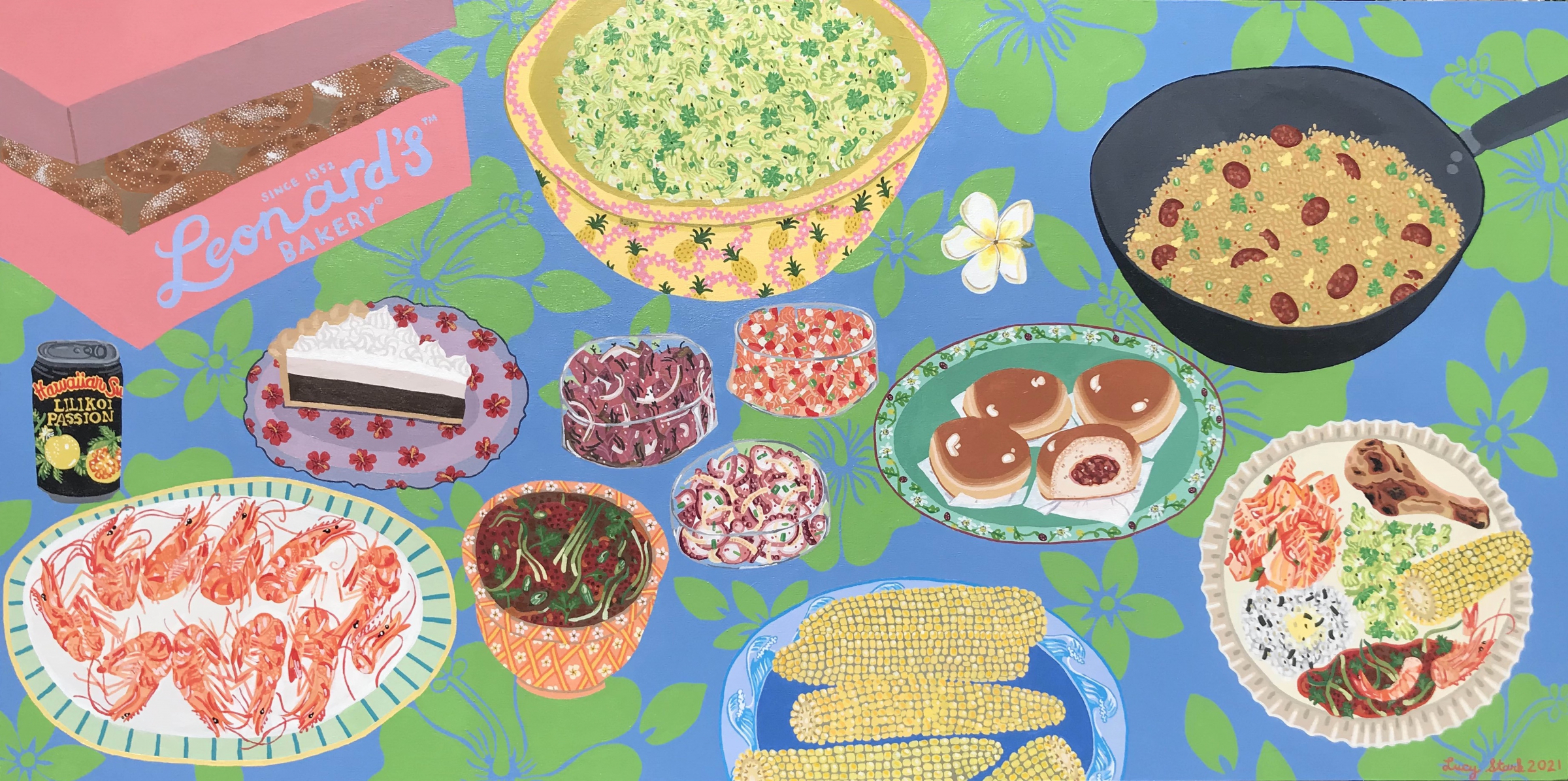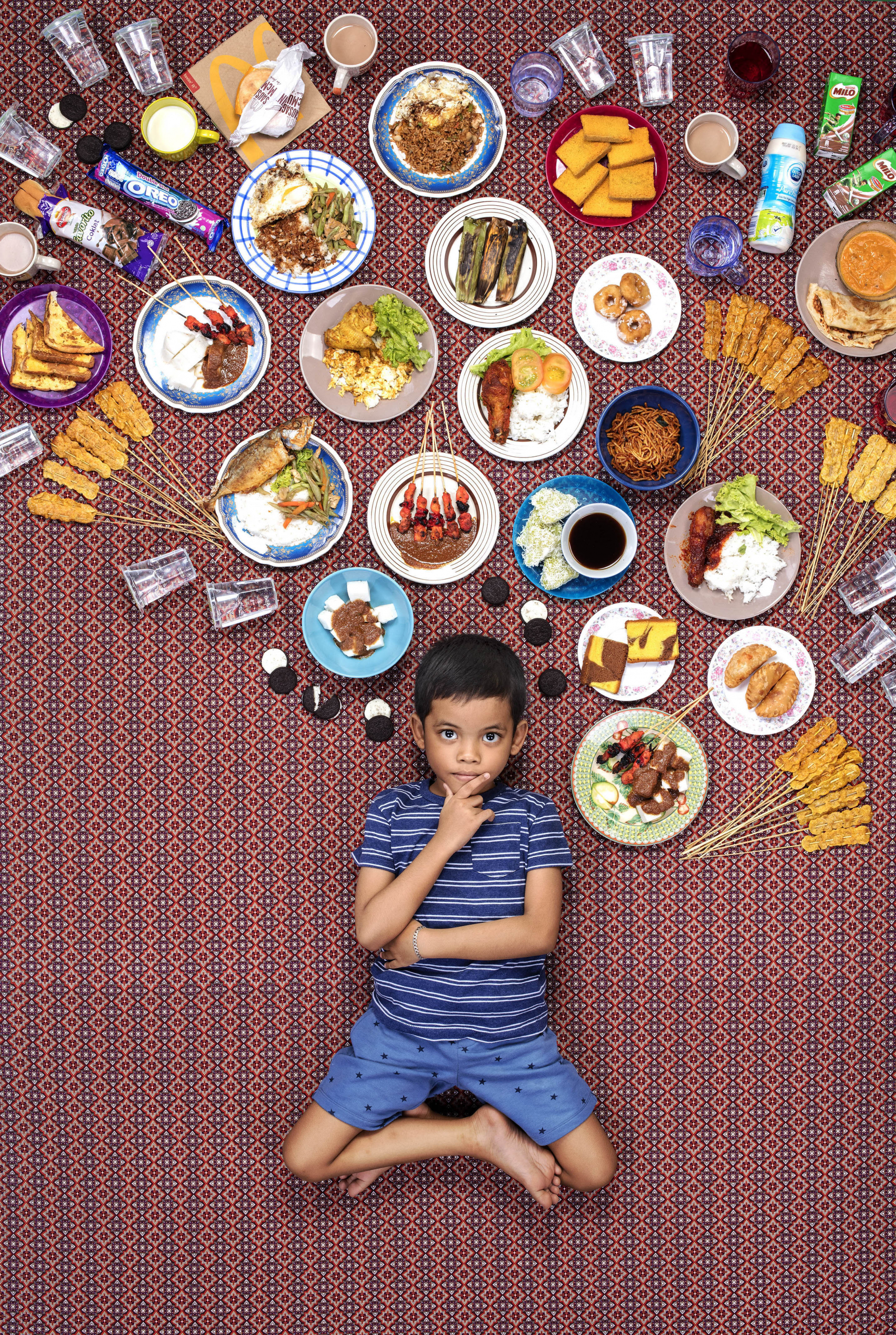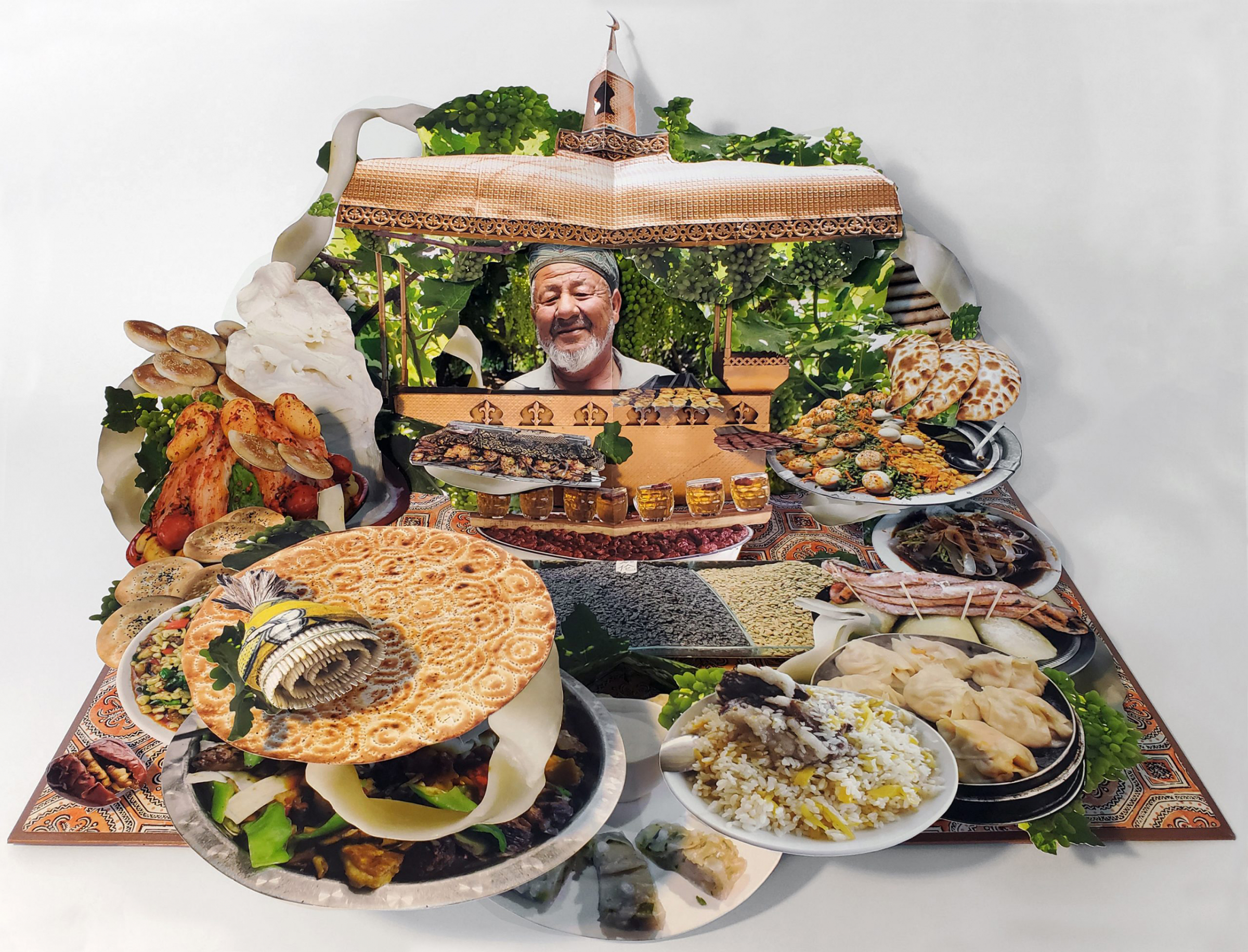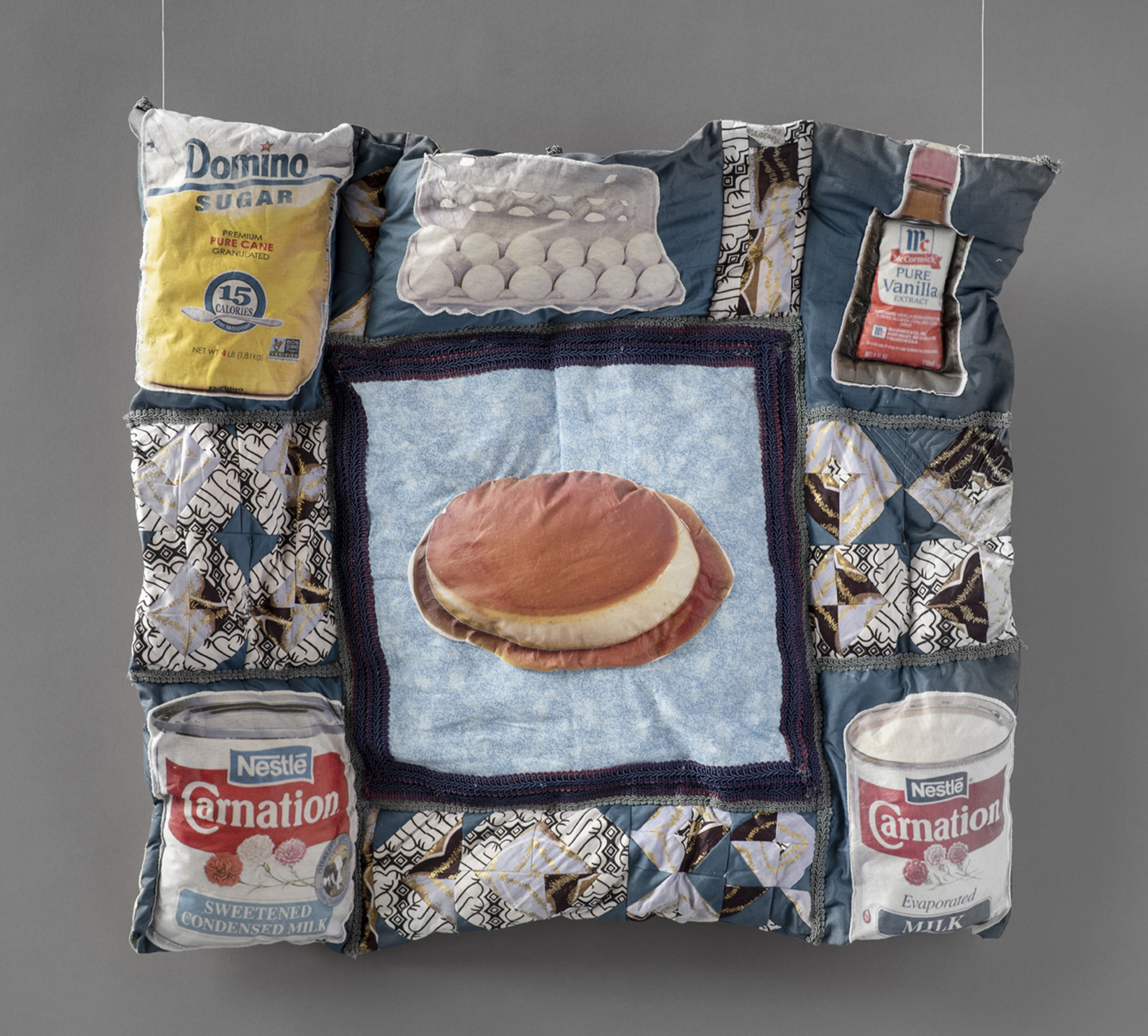As an essential component of human life, it is not surprising that food, in its many shapes and forms, has been the subject matter of art dating back to the Egyptians, who carved pictographs of crops and bread on the walls of the pyramids. During the Dutch Baroque era, still-life paintings of lusciously ripe fruit were a symbol of wealth and taste. Poverty and despair were effectively portrayed by Van Gogh in his iconic "The Potato Eaters" and Cezanne used food as geometric objects in order to push traditional ideas about representation towards abstraction. Fast forward to the 1960's Pop Era, when Warhol and Oldenburg had great fun presenting comestibles in serial form and grandiose size.
It seems there will always be something to say about food, and our relationship to it, a topic engagingly explored in the current show at the Palo Alto Art Center. Entitled "In Feast or Famine," the multimedia group exhibition is on view Jan. 20 to April 6.
The exhibition is the first of a year-long series that will, according to Palo Alto Art Center Director Karen Kienzle, "showcase the power of food to connect us to identity, culture and each other. Artists have always found creative inspiration in all things edible." Independent curator Marianne McGrath was hired to organize the show, which was inspired by her own interest in food and food history. In the midst of the pandemic, she realized that one of the things she missed most was gathering with others over a meal.
"I felt that the topic of food is globally relevant and something that everyone can relate to," she said. "Food might be our first introduction to 'making' something with a process, specific materials, and intended outcome, like art. A recipe, menu or meal can be a medium — along with art — to open the door to self-expression, shared community and new cultures."
McGrath explained that she has followed some of the 24 artists in the exhibition, while others came from networking over a several-year period. There are artists of many ethnic backgrounds represented and an impressive array of media, including photography, painting, sculpture, printmaking and video art.
At first glance, the exhibition seems bright, colorful, even cheerful, with lots of charming representations of foods we all know and love. (Entering with a full stomach might be advisable). But looking more carefully, and reading the labels, will clue you in to the fact that each of these artists has a thoughtful, or thought-provoking, statement to make about the subject.
Painter Chelsea Wong explores how gathering around the table achieves more than sustenance in "A Modern Feast." The perspective might be flat, but the highly patterned background and brightly hued clothing of the five smiling diners exude a feeling of goodwill and enjoyment. Wong noted that, "In a culture where openly expressing feelings doesn't always come naturally, feeding one another is how we show love."
In contrast, Narsiso Martinez, a native of Oaxaca, Mexico, would like us to think about what it takes to get food onto our tables. In his multimedia work, "Hollywood and Vine" we are confronted with the knowledge that farm workers, like the woman portrayed, undertake hard work and long hours in the fields of this state and others. The artist explained that he positioned her, standing on a black star, in order to resemble the celebrity heroes from the walk of fame in Los Angeles. Look closely and you will note that discarded produce boxes form the background of this piece.
Tackling the notion that "we are what we eat" and just how beneficial — or detrimental — that can be, photographer Gregg Segal traveled around the world taking portraits of children. For his "Daily Bread" series, he had a specific request for each child: keep a journal of what you eat in one week. Examples from this inventory were then placed around each child for the portrait. The results, shown in these large, detailed pictures are fascinating. Yes, we would expect to see foods central to the child's ethnic group (he visited Malaysia, Dubai, Sicily, France, Brazil and Los Angeles) in each one, as well as a lot of cross-over dishes (pizza and spaghetti), but it is apparent that soft drinks and processed foods have also become the norm. Concerned about the epidemic of childhood obesity and chronic health problems related to diet, Segal hopes the series will be "a catalyst for change and a link to a growing, grassroots community that is moving the needle on diet."
Several of the artists are interested in the various ways we obtain food. Suhas Bhujbal's painting, "Market #25" shows a throng of people interacting over food purchases, an act that looks as similar in the streets of India as it does on California Avenue. Kim Cogan's Hopper-esque oil painting of a neighborhood liquor store "Friday Evening," is both familiar and haunting in its quiet stillness. Our penchant for packaged foods is treated with almost surrealistic detail by Stefanie Herr in her photographic sculptures. You might be tempted to touch the bisected rabbit in "Happy Hunting Grounds: Carrot Cascade" to see if you can, indeed, feel the fur.
On a lighter note, Jeanne F. Jalandoni's "Recipe Quilt (Beef Empanadas)" and "Recipe Quilt (Leche Flan)" are fun and playful. Ingredients for the foodstuffs (created with iron-on prints) surround the center of a square, where soft and fluffy empanadas or a dish of flan burst out in three dimensions. Leslie Lewis Sigler's exquisitely painted portraits of cutlery anthropomorphize everyday objects we use but rarely consider. Sigler explained that she was drawn to these silver family heirlooms because "they seem to have an eternal life." With names like "The Disruptor," "The Honorable" and "The Tiger and the Dragon," it is clear that the artist sees more than just a functional object. Instead, she said, they have "the power to reflect our own life stories and family histories."
McGrath included an historical note to the show with three vintage ration posters from the collection of the Hoover Institution at Stanford University. Their World War I-era propaganda messages reinforce the notion that wartime often brings food scarcity and the need to conserve. They might be dated, but the suggestions in "Food … don't waste it" from 1917 ("buy with thought, cook it with care, buy local foods") are just as relevant today.
For a final dessert, stand in front of Wayne Thiebaud's "Neapolitan Pie." Thiebaud, a well-known purveyor of sumptuous treats (in painted form) is at his best here. The dreamy soft layers of chocolate, vanilla and strawberry ice cream, capped with a coating of whipped cream will have you raiding the freezer when you get home.
There is much to take in here, and definitely something for everybody. McGrath hopes that the viewer will appreciate the skills and talents of the artists represented as well as the bigger message. "I hope visitors will think about the amazing people who grow, harvest, transport and prepare our food, appreciate them, their lives and labor."
"In Feast or Famine" is on view Jan. 20 through April 7 at the Palo Alto Art Center, 1313 Newell Road, Palo Alto. An opening reception with artmaking activities takes place Jan. 26, 6 p.m. Admission is free. For more information, go to cityofpaloalto.org.






Comments